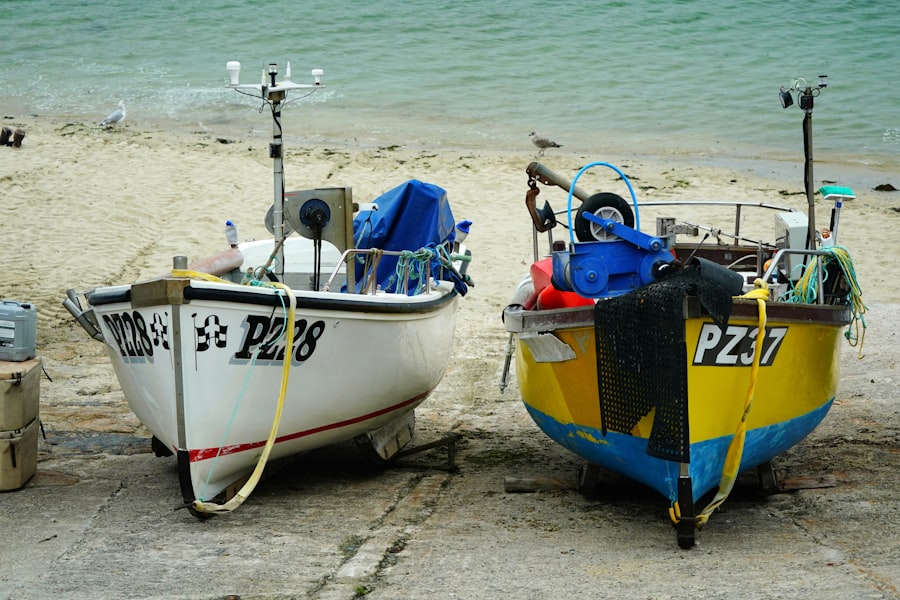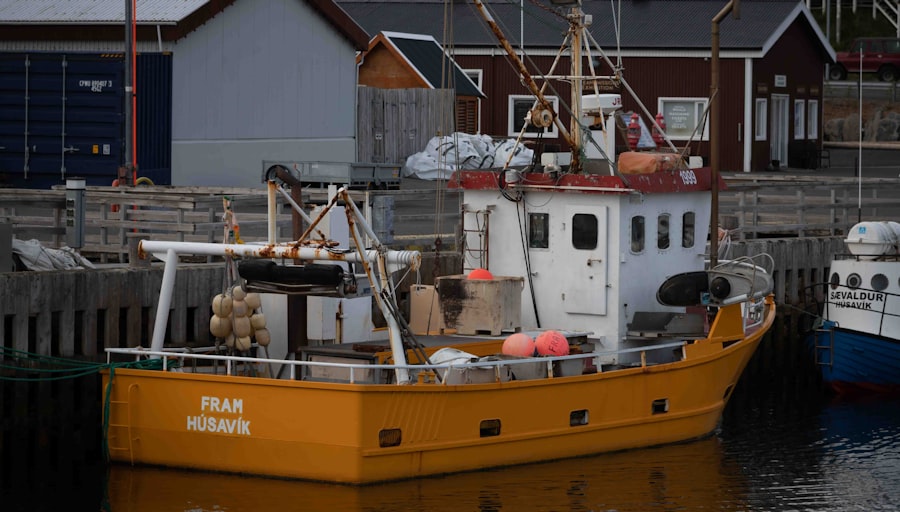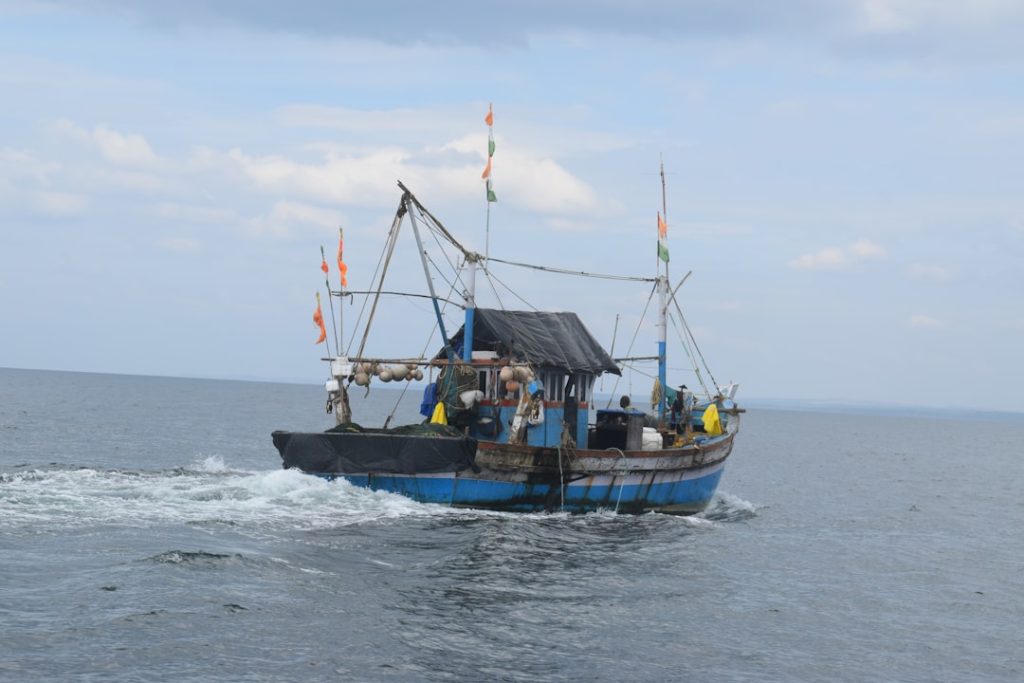Trawlers are a unique category of boats that have gained popularity among both recreational and commercial boaters. Unlike other types of vessels, trawlers are designed primarily for long-distance cruising and extended stays on the water. Their hulls are typically characterized by a full displacement design, which allows them to glide smoothly through the water at lower speeds.
This design not only enhances fuel efficiency but also provides a stable platform for living aboard. The combination of a robust build and spacious interiors makes trawlers particularly appealing for those who wish to explore coastal waters or undertake longer voyages. One of the defining features of trawlers is their emphasis on comfort and livability.
Many models come equipped with amenities that rival those found in a small apartment, including full kitchens, multiple sleeping quarters, and even bathrooms with showers. This focus on comfort is complemented by the practical layout of the vessel, which often includes wide decks and easy access to various areas of the boat. The result is a vessel that is not only capable of handling rough seas but also provides a welcoming environment for families or groups of friends looking to spend quality time together on the water.
Key Takeaways
- Trawlers are unique boats designed for long-range cruising with fuel efficiency and comfort.
- Choosing the right trawler depends on your specific needs, including size, range, and onboard amenities.
- Various models offer different features, so exploring options helps match your lifestyle and preferences.
- Budgeting should account for purchase price, maintenance, and operational costs.
- Inspecting trawlers thoroughly and considering professional broker assistance can ensure a smart purchase.
Finding the Right Trawler for Your Needs
When embarking on the journey to find the right trawler, it is essential to first assess your specific needs and preferences. Consider how you plan to use the boat—will it be for weekend getaways, extended cruising, or perhaps even living aboard full-time? Each of these scenarios may require different features and specifications.
For instance, if you envision long voyages, you might prioritize fuel efficiency and storage capacity for provisions. Conversely, if your focus is on weekend trips, you may want a model that is easier to handle and maintain. Another critical factor to consider is the size of the trawler.
Trawlers come in various lengths, typically ranging from 30 to over 50 feet. A larger vessel may offer more living space and amenities but can also be more challenging to maneuver and dock. On the other hand, a smaller trawler may be easier to handle but could lack some comforts or storage options.
It’s important to strike a balance between size and functionality based on your intended use and comfort level with operating a larger boat.
Exploring Different Trawler Models and Features

The market for trawlers is diverse, with numerous manufacturers offering a wide range of models, each with its own set of features. Some popular brands include Grand Banks, Nordic Tug, and Kadey-Krogen, each known for their quality craftsmanship and reliability. When exploring different models, it’s crucial to pay attention to the specific features that can enhance your boating experience.
For example, some trawlers come equipped with flybridges that provide an elevated vantage point for navigation and socializing, while others may offer spacious cockpits ideal for fishing or entertaining. In addition to layout and design features, consider the propulsion systems available in various trawler models. Many modern trawlers utilize diesel engines known for their durability and fuel efficiency.
However, some newer models are beginning to incorporate hybrid systems or even electric propulsion options, which can significantly reduce environmental impact while providing quiet operation. Understanding these options will help you make an informed decision based on your cruising style and environmental considerations.
Budgeting for a Trawler Purchase
| Category | Estimated Cost | Description |
|---|---|---|
| Purchase Price | 150,000 – 500,000 | Cost of buying a new or used trawler |
| Inspection and Survey | 1,000 – 3,000 | Professional evaluation of the vessel’s condition |
| Registration and Documentation | 500 – 1,500 | Legal paperwork and registration fees |
| Insurance | 2,000 – 5,000 annually | Coverage for damage, liability, and theft |
| Maintenance and Repairs | 5,000 – 15,000 annually | Routine upkeep and unexpected repairs |
| Fuel Costs | 3,000 – 10,000 annually | Fuel consumption depending on usage |
| Docking and Storage | 2,000 – 8,000 annually | Marina fees or storage costs |
| Equipment and Upgrades | 1,000 – 10,000 | Navigation, safety gear, and comfort upgrades |
| Training and Licensing | 500 – 2,000 | Boating courses and licenses |
Budgeting for a trawler purchase involves more than just the initial cost of the vessel; it requires a comprehensive understanding of ongoing expenses associated with ownership. The price of a new trawler can range from tens of thousands to several million dollars, depending on size, brand, and features. However, it’s essential to factor in additional costs such as insurance, maintenance, docking fees, fuel, and potential upgrades or modifications you may want to make after purchase.
When creating your budget, consider setting aside funds for unexpected repairs or emergencies. Boats are subject to wear and tear from exposure to saltwater and harsh weather conditions, so having a financial cushion can alleviate stress when issues arise. Additionally, if you plan to finance your purchase, explore different loan options and interest rates to find a solution that fits your financial situation.
Understanding the total cost of ownership will help you make a more informed decision when selecting your ideal trawler.
Important Considerations When Buying a Trawler
As you navigate the process of purchasing a trawler, several important considerations should guide your decision-making. First and foremost is the vessel’s condition—whether you are looking at new or used models. If considering a used trawler, it’s vital to conduct thorough inspections to assess its structural integrity and mechanical systems.
Look for signs of wear such as rust, leaks, or damage to the hull. A professional marine surveyor can provide an unbiased evaluation of the boat’s condition and help identify any potential issues that may not be immediately visible. Another key consideration is the intended cruising grounds.
Different trawlers are designed for various types of waters—some are better suited for coastal cruising while others are built for offshore adventures. Understanding where you plan to take your trawler will influence your choice in terms of size, hull design, and equipment. Additionally, consider how many people will typically be aboard; this will affect not only the size of the vessel but also its layout and amenities.
Where to Look for Trawlers for Sale

Finding the right trawler requires knowing where to look. There are several avenues available for prospective buyers, each with its own advantages. Online marketplaces such as YachtWorld and Boat Trader offer extensive listings of new and used trawlers from various manufacturers and private sellers.
These platforms allow you to filter searches based on specific criteria such as price range, size, and location, making it easier to find options that meet your needs. In addition to online resources, attending boat shows can provide valuable opportunities to see different models up close and speak directly with manufacturers or dealers. Boat shows often feature a wide range of vessels in one location, allowing you to compare various models side by side.
Networking with other boaters at these events can also yield insights into their experiences with specific brands or models, helping you make a more informed decision.
Working with a Broker to Find Your Perfect Trawler
Engaging a yacht broker can be an invaluable step in your search for the perfect trawler. Brokers possess extensive knowledge of the market and can help streamline the buying process by providing access to listings that may not be publicly available. They can also assist in negotiating prices and terms on your behalf, ensuring that you get the best deal possible.
A good broker will take the time to understand your needs and preferences, guiding you toward options that align with your vision for boating. Moreover, brokers often have established relationships with surveyors and marine service providers, which can facilitate inspections and repairs if needed. Their expertise can save you time and effort while providing peace of mind throughout the purchasing process.
When selecting a broker, look for someone with experience in trawlers specifically; their specialized knowledge will be crucial in helping you navigate this unique segment of the boating market.
Tips for Inspecting and Evaluating Trawlers for Sale
When inspecting potential trawlers for purchase, it’s essential to approach the evaluation process methodically. Start by examining the exterior of the vessel; check for any signs of damage or wear on the hull, deck, and superstructure. Pay close attention to areas prone to moisture accumulation such as hatches and windows; leaks in these areas can lead to significant issues down the line if not addressed promptly.
Once you’ve assessed the exterior, move inside to evaluate the living spaces. Check all systems including plumbing, electrical components, heating or air conditioning units, and appliances to ensure they are functioning correctly. Take note of any unusual odors or signs of mold or mildew that could indicate water intrusion or poor ventilation.
If possible, request maintenance records from the current owner; these documents can provide insight into how well the boat has been cared for over time. In addition to physical inspections, consider taking the trawler out for a sea trial if feasible. This experience will allow you to assess how the vessel handles in real-world conditions and whether it meets your expectations in terms of performance and comfort while underway.
Engaging in this hands-on evaluation will provide critical information that can influence your final decision on whether this particular trawler is indeed the right fit for your boating lifestyle.


